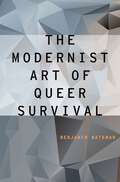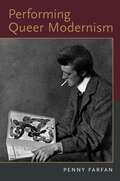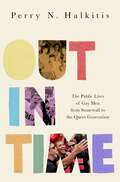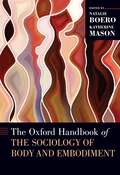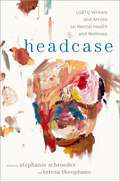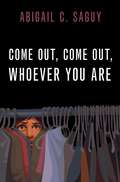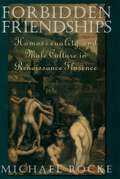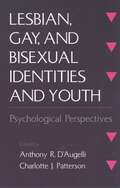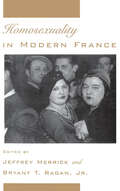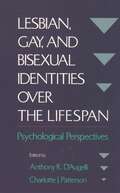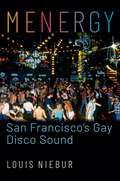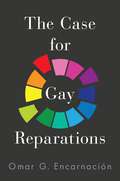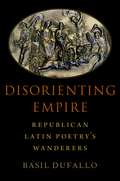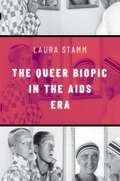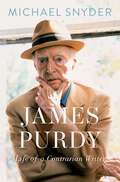- Table View
- List View
The Modernist Art of Queer Survival (Modernist Literature and Culture)
by Benjamin BatemanWhether we speak of queer bodies targeted for harassment, queer sensibilities derided as dangerous, or queer intimacies denied legitimacy, we acknowledge a close companionship between queerness and precariousness. Queerness remains continuously under threat; these threats to survival can be immediate, as in the AIDS crises, or more subtle and entrenched. Many queer lives thus end prematurely and drastically-but not all end in the physical expiration of life. Some terminate gradually and even unconsciously in the countless concessions to normativity demanded by dominant cultures that perceive, through a perverse set of projective identifications, their own survival as imperiled by queerness. The Modernist Art of Queer Survival explores an archive of modernist archive of modernist literature that conceives survival as a collective enterprise linking lives across boundaries of race, time, class, species, gender, and sexuality. As social Darwinism promoted a selfish, competitive, and combatively individualistic understanding of survival, the five modernists examined in The Modernist Art of Queer Survival countered by imagining how postures of precarity, vulnerability, humility, and receptivity can breed pleasurably and ecologically sustainable modes of interdependent survival. These modes prove particularly vital and appealing to queer bodies, desires, and intimacies deemed unfit, abnormal, or unproductive by heterosexist ideologies. Authors and texts discussed include Henry James's "The Beast in the Jungle," Oscar Wilde's De Profundis, E.M. Forster's Howards End and A Passage to India, and Willa Cather's "Consequences" and Lucy Gayheart.
Performing Queer Modernism
by Penny FarfanFocusing on some of the best-known and most visible stage plays and dance performances of the late nineteenth- and early twentieth-centuries, Penny Farfan's interdisciplinary study demonstrates that queer performance was integral to and productive of modernism, that queer modernist performance played a key role in the historical emergence of modern sexual identities, and that it anticipated, and was in a sense foundational to, the insights of contemporary queer modernist studies. Chapters on works from Vaslav Nijinsky's Afternoon of a Faun to Noël Coward's Private Lives highlight manifestations of and suggest ways of reading queer modernist performance. Together, these case studies clarify aspects of both the queer and the modernist, and how their co-productive intersection was articulated in and through performance on the late-nineteenth- and early-twentieth-century stage. Performing Queer Modernism thus contributes to an expanded understanding of modernism across a range of performance genres, the central role of performance within modernism more generally, and the integral relation between performance history and the history of sexuality. It also contributes to the ongoing transformation of the field of modernist studies, in which drama and performance remain under-represented, and to revisionist historiographies that approach modernist performance through feminist and queer critical perspectives and interdisciplinary frameworks and that consider how formally innovative as well as more conventional works collectively engaged with modernity, at once reflecting and contributing to historical change in the domains of gender and sexuality.
PERFORMING QUEER MODERNISM C
by Penny FarfanFocusing on some of the best-known and most visible stage plays and dance performances of the late nineteenth- and early twentieth-centuries, Penny Farfan's interdisciplinary study demonstrates that queer performance was integral to and productive of modernism, that queer modernist performance played a key role in the historical emergence of modern sexual identities, and that it anticipated, and was in a sense foundational to, the insights of contemporary queer modernist studies. Chapters on works from Vaslav Nijinsky's Afternoon of a Faun to Noël Coward's Private Lives highlight manifestations of and suggest ways of reading queer modernist performance. Together, these case studies clarify aspects of both the queer and the modernist, and how their co-productive intersection was articulated in and through performance on the late-nineteenth- and early-twentieth-century stage. Performing Queer Modernism thus contributes to an expanded understanding of modernism across a range of performance genres, the central role of performance within modernism more generally, and the integral relation between performance history and the history of sexuality. It also contributes to the ongoing transformation of the field of modernist studies, in which drama and performance remain under-represented, and to revisionist historiographies that approach modernist performance through feminist and queer critical perspectives and interdisciplinary frameworks and that consider how formally innovative as well as more conventional works collectively engaged with modernity, at once reflecting and contributing to historical change in the domains of gender and sexuality.
Out in Time: The Public Lives of Gay Men from Stonewall to the Queer Generation
by Perry N. HalkitisThe civil rights of LGBTQ people have slowly yet steadily strengthened since the Stonewall Riots of June, 1969. Despite enormous opposition from some political segments and the catastrophic effects of the AIDS crisis, the last five decades have witnessed improvement in the conditions of the lives of LGBTQ individuals in the United States. As such, the realities and challenges faced by a young gay man coming of age and coming out in the 1960s is, in many profound ways, different from the experiences of a young gay man coming of age and coming out today. Out in Time explores the life experiences of three generations of gay men --the Stonewall, AIDS, and Queer generations-- arguing that while there are generational differences in the lived experiences of young gay men, each one confronts its own unique historical events, realities, and socio-political conditions, there are consistencies across time that define and unify the identity formation of gay men. Guided by the vast research literature on gay identity formation and coming out, the ideas and themes explored here are seen through the oral histories of a diverse set of fifteen gay men, five from each generation. Out in Time demonstrates how early life challenges define and shape the life courses of gay men, demarcating both the specific time-bound challenges encountered by each generation, and the universal challenges encountered by gay men coming of age across all generations and the conditions that define their lives.
Out in Time: The Public Lives of Gay Men from Stonewall to the Queer Generation
by Perry N. HalkitisThe civil rights of LGBTQ people have slowly yet steadily strengthened since the Stonewall Riots of June, 1969. Despite enormous opposition from some political segments and the catastrophic effects of the AIDS crisis, the last five decades have witnessed improvement in the conditions of the lives of LGBTQ individuals in the United States. As such, the realities and challenges faced by a young gay man coming of age and coming out in the 1960s is, in many profound ways, different from the experiences of a young gay man coming of age and coming out today. Out in Time explores the life experiences of three generations of gay men --the Stonewall, AIDS, and Queer generations-- arguing that while there are generational differences in the lived experiences of young gay men, each one confronts its own unique historical events, realities, and socio-political conditions, there are consistencies across time that define and unify the identity formation of gay men. Guided by the vast research literature on gay identity formation and coming out, the ideas and themes explored here are seen through the oral histories of a diverse set of fifteen gay men, five from each generation. Out in Time demonstrates how early life challenges define and shape the life courses of gay men, demarcating both the specific time-bound challenges encountered by each generation, and the universal challenges encountered by gay men coming of age across all generations and the conditions that define their lives.
The Oxford Handbook of the Sociology of Body and Embodiment (Oxford Handbooks)
In popular debates over the influences of nature versus culture on human lives, bodies are often assigned to the category of "nature": biological, essential, and pre-social. The Oxford Handbook of the Sociology of Body and Embodiment challenges that view, arguing that bodies both shape and get shaped by human societies. As such, the body is an appropriate and necessary area of study for sociologists. The Handbook works to clarify the scope of this topic and display the innovations of research within the field. The volume is divided into three main parts: Bodies and Methodology; Marginalized Bodies; and Embodied Sociology. Sociologists contributing to the first two parts focus on the body and the ways it is given meaning, regulated, and subjected to legal and medical oversight in a variety of social contexts (particularly when the body in question violates norms for how a culture believes bodies "ought" to behave or appear). Sociologists contributing to the last part use the bodily as a lens through which to study social institutions and experiences. These social settings range from personal decisions about medical treatment to programs for teaching police recruits how to use physical force, from social movement tactics to countries' understandings of race and national identity. The Oxford Handbook of the Sociology of the Body also prioritizes empirical evidence and methodological rigor, attending to the ways particular lives are lived in particular physical bodies located within particular cultural and institutional contexts. Many chapters offer extended methodological reflections, providing guidance on how to conduct sociological research on the body and, at times, acknowledging the role the authors' own bodies play in developing their knowledge of the research subject.
The Oxford Handbook of the Sociology of Body and Embodiment (Oxford Handbooks)
by Katherine Mason Natalie BoeroIn popular debates over the influences of nature versus culture on human lives, bodies are often assigned to the category of "nature": biological, essential, and pre-social. The Oxford Handbook of the Sociology of Body and Embodiment challenges that view, arguing that bodies both shape and get shaped by human societies. As such, the body is an appropriate and necessary area of study for sociologists. The Handbook works to clarify the scope of this topic and display the innovations of research within the field. The volume is divided into three main parts: Bodies and Methodology; Marginalized Bodies; and Embodied Sociology. Sociologists contributing to the first two parts focus on the body and the ways it is given meaning, regulated, and subjected to legal and medical oversight in a variety of social contexts (particularly when the body in question violates norms for how a culture believes bodies "ought" to behave or appear). Sociologists contributing to the last part use the bodily as a lens through which to study social institutions and experiences. These social settings range from personal decisions about medical treatment to programs for teaching police recruits how to use physical force, from social movement tactics to countries' understandings of race and national identity. The Oxford Handbook of the Sociology of the Body also prioritizes empirical evidence and methodological rigor, attending to the ways particular lives are lived in particular physical bodies located within particular cultural and institutional contexts. Many chapters offer extended methodological reflections, providing guidance on how to conduct sociological research on the body and, at times, acknowledging the role the authors' own bodies play in developing their knowledge of the research subject.
Headcase: LGBTQ Writers & Artists on Mental Health and Wellness
Headcase is a groundbreaking collection of personal reflections and artistic representations illustrating the intersection of mental wellness, mental illness, and LGBTQ identity, as well as the lasting impact of historical views equating queer and trans identity with mental illness. The featured pieces offer personal views from both providers and clients, often one and the same, about their experiences. In the anthology, readers will access the inner thoughts of contributors who collectively document the difficulty of navigating flawed healthcare systems that limit affordable access to genuinely affirming, effective services. Traversing boundaries of race and ethnic identity, age, gender identity, and socioeconomic status, Headcase appeals to LGBTQ communities and, specifically, LGBTQ mental health consumers and their friends, families, and comrades.
Headcase: LGBTQ Writers & Artists on Mental Health and Wellness
by Stephanie Schroeder and Teresa TheophanoHeadcase is a groundbreaking collection of personal reflections and artistic representations illustrating the intersection of mental wellness, mental illness, and LGBTQ identity, as well as the lasting impact of historical views equating queer and trans identity with mental illness. The featured pieces offer personal views from both providers and clients, often one and the same, about their experiences. In the anthology, readers will access the inner thoughts of contributors who collectively document the difficulty of navigating flawed healthcare systems that limit affordable access to genuinely affirming, effective services. Traversing boundaries of race and ethnic identity, age, gender identity, and socioeconomic status, Headcase appeals to LGBTQ communities and, specifically, LGBTQ mental health consumers and their friends, families, and comrades.
Come Out, Come Out, Whoever You Are
by Abigail C. SaguyWhile people used to conceal the fact that they were gay or lesbian to protect themselves from stigma and discrimination, it is now commonplace for people to "come out" and encourage others to do so as well. Come Out, Come Out, Whoever You Are systematically examines how coming out has moved beyond gay and lesbian rights groups and how different groups wrestle with the politics of coming out in their efforts to resist stigma and enact social change. It shows how different experiences and disparate risks of disclosure shape these groups' collective strategies. Through scores of interviews with LGBTQ+ people, undocumented immigrant youth, fat acceptance activists, Mormon fundamentalist polygamists, and sexual harassment lawyers and activists in the era of the #MeToo movement, Come Out, Come Out, Whoever You Are explains why so many different groups gravitate toward the term coming out. By focusing on the personal and political resonance of coming out, it provides a novel way to understand how identity politics work in America today.
COME OUT,COME OUT,WHOEVER YOU ARE C
by Abigail C. SaguyWhile people used to conceal the fact that they were gay or lesbian to protect themselves from stigma and discrimination, it is now commonplace for people to "come out" and encourage others to do so as well. Come Out, Come Out, Whoever You Are systematically examines how coming out has moved beyond gay and lesbian rights groups and how different groups wrestle with the politics of coming out in their efforts to resist stigma and enact social change. It shows how different experiences and disparate risks of disclosure shape these groups' collective strategies. Through scores of interviews with LGBTQ+ people, undocumented immigrant youth, fat acceptance activists, Mormon fundamentalist polygamists, and sexual harassment lawyers and activists in the era of the #MeToo movement, Come Out, Come Out, Whoever You Are explains why so many different groups gravitate toward the term coming out. By focusing on the personal and political resonance of coming out, it provides a novel way to understand how identity politics work in America today.
Forbidden Friendships: Homosexuality and Male Culture in Renaissance Florence (Studies in the History of Sexuality)
by Michael Rocke"This is a superb work of scholarship, impossible to overpraise.... It marks a milestone in the 20-year rise of gay and lesbian studies."--Martin Duberman, The Advocate The men of Renaissance Florence were so renowned for sodomy that "Florenzer" in German meant "sodomite." In the late fifteenth century, as many as one in two Florentine men had come to the attention of the authorities for sodomy by the time they were thirty. In 1432 The Office of the Night was created specifically to police sodomy in Florence. Indeed, nearly all Florentine males probably had some kind of same-sex experience as a part of their "normal" sexual life. Seventy years of denunciations, interrogations, and sentencings left an extraordinarily detailed record, which author Michael Rocke has used in his vivid depiction of this vibrant sexual culture in a world where these same-sex acts were not the deviant transgressions of a small minority, but an integral part of a normal masculine identity. Rocke roots this sexual activity in the broader context of Renaissance Florence, with its social networks of families, juvenile gangs, neighbors, patronage, workshops, and confraternities, and its busy political life from the early years of the Republic through the period of Lorenzo de' Medici, Savonarola, and the beginning of Medici princely rule. His richly detailed book paints a fascinating picture of Renaissance Florence and calls into question our modern conceptions of gender and sexual identity.
Lesbian, Gay, and Bisexual Identities and Youth: Psychological Perspectives
by Anthony R. D'Augelli Charlotte J. PattersonChanges in biological processes, relationships, and community interactions influence the emergence of sexuality in all young people. The process is more complex and difficult for lesbian, gay and bisexual (LGB) teenagers. Fortunately, the cultural changes that have allowed LGB youths to become more open about themselves at earlier ages have also allowed social and behavioral scientists the opportunity to study them. The essays in this volume explore the psychological dimensions of LGB identities from puberty to adulthood. The essays focus on three general areas: theoretical frameworks that are important in understanding the development of sexual orientation in adolescence, challenges faced by LGB youth, and issues related to interventions and services for LGB youths in community settings. This volume presents authoritative, research-based reviews of this ever-increasing area of study and social concern.
Homosexuality in Modern France (Studies in the History of Sexuality)
by Jeffrey Merrick Bryant T. RaganThis volume explores the realities and representations of same-sex sexuality in France in the eighteenth, nineteenth, and twentieth centuries, the period that witnessed the emergence of "homosexuality" in the modern sense of the word. Based on archival research and textual analysis, the articles examine the development of homosexual subcultures and illustrate the ways in which philosophes, pamphleteers, police, novelists, scientists, and politicians conceptualized same-sex relations and connected them with more general concerns about order and disorder. The contributors--Elizabeth Colwill, Michael David Sibalis, Victoria Thompson, William Peniston, Vernon Rosario II, Francesca Canade-Sautman, Martha Hanna, Robert A. Nye, and the editors Bryant T. Ragan, Jr. and Jeffrey Merrick--use the methods of intellectual and cultural history, the history of science, literary studies, legal and social history, and microhistory. This collection shows how the subject of homosexuality is related to important topics in French history: the Enlightenment, the revolutionary tradition, social discipline, positivism, elite and popular culture, nationalism, feminism, and the construction of identity. Given the role of gays and lesbians in modern French culture and the work of French scholars on the history of sexuality, this collection fills an important gap in the literature and represents the first attempt in any language to explore this subject over three centuries from a variety of perspectives.
Lesbian, Gay, and Bisexual Identities over the Lifespan: Psychological Perspectives
Over the last fifteen years, psychological research regarding sexual orientation has seen explosive growth. In this book, Anthony R. D'Augelli and Charlotte J. Patterson bring together top experts to offer a comprehensive overview of what we have discovered--and what we still need to learn--about lesbian, gay, and bisexual identities. Writing in clear, nontechnical language, the contributors cover a range of topics, including conceptions of sexual identity, development over the lifespan, family and other personal relationships, parenting, and bigotry and discrimination. Lesbian, Gay, and Bisexual Identities Over the Lifespan is essential reading for researchers, students, social scientists, mental health practitioners, and general readers who seek the most up-to-date and authoritative treatment of the subject available.
Menergy: San Francisco's Gay Disco Sound
by Louis NieburFor most of the US, disco died in 1979. Triggered by the infamous "Disco Demolition" night at Comiskey Park in Chicago on July 12, 1979, a backlash made the word "disco" an overnight punchline. Major labels dropped disco artists and producers, and those mainstream musicians who had jumped on the bandwagon just as quickly threw themselves off. Gay men, however, continued to dance, and in the gay enclave of the Castro District in San Francisco, enterprising gay DJs, record producers, and musicians started their own small dance music record labels to make up for the lack of new, danceable music. Almost immediately this music reached far beyond the Bay, with Megatone Records, Moby Dick Records, and other labels achieving worldwide success, creating the world's first gay-owned, gay-produced music for a dancing audience. This music reflected a new way of life, a world apart and a culture of sexual liberation for gay men especially. With Menergy, author Louis Niebur offers a project of reconstruction in order to restore these lost figures to their rightful place in the legacy of 20th-century popular music. Menergy is the product of years of research, with dozens of personal interviews, archival research drawing upon hundreds of contemporary journals, photographs, bar rags, diaries, nightclub ephemera, and, most importantly, the recordings of the San Francisco artists themselves. With its combination of popular music theory, cultural analysis, queer theory and gender studies, and traditional musical analysis, the book will appeal to readers in queer history, popular music history, and electronic dance music.
Menergy: San Francisco's Gay Disco Sound
by Louis NieburFor most of the US, disco died in 1979. Triggered by the infamous "Disco Demolition" night at Comiskey Park in Chicago on July 12, 1979, a backlash made the word "disco" an overnight punchline. Major labels dropped disco artists and producers, and those mainstream musicians who had jumped on the bandwagon just as quickly threw themselves off. Gay men, however, continued to dance, and in the gay enclave of the Castro District in San Francisco, enterprising gay DJs, record producers, and musicians started their own small dance music record labels to make up for the lack of new, danceable music. Almost immediately this music reached far beyond the Bay, with Megatone Records, Moby Dick Records, and other labels achieving worldwide success, creating the world's first gay-owned, gay-produced music for a dancing audience. This music reflected a new way of life, a world apart and a culture of sexual liberation for gay men especially. With Menergy, author Louis Niebur offers a project of reconstruction in order to restore these lost figures to their rightful place in the legacy of 20th-century popular music. Menergy is the product of years of research, with dozens of personal interviews, archival research drawing upon hundreds of contemporary journals, photographs, bar rags, diaries, nightclub ephemera, and, most importantly, the recordings of the San Francisco artists themselves. With its combination of popular music theory, cultural analysis, queer theory and gender studies, and traditional musical analysis, the book will appeal to readers in queer history, popular music history, and electronic dance music.
The Case for Gay Reparations
by Omar G. EncarnaciónA compelling and timely vision for gay reparations in the United States In the last two decades many nations have adopted "gay reparations," or policies intended to make amends for a history of discrimination, stigmatization, and violence on the basis of sexual orientation and gender identity. Far from being a homogenous or uniform phenomenon, gay reparations encompass a small constellation of approaches including a formal apology to the LGBT community for past wrongdoing, financial compensation for victims of anti-LGBT laws and actions, and the erection of monuments to the memory of those who suffered because of structural homophobia. The United States, however, has been reluctant to embrace gay reparations, making the country something of an outlier among Western democracies. Beyond making the case for gay reparations in the United States, this book explores a wide range of questions provoked by the rise of the gay reparations movement. Among these questions, three stand out for what they reveal about the puzzling and complex nature of this new front in the struggle for LGBT equality. Why, after centuries of attempts to marginalize, dehumanize, and even eradicate LGBT people, are governments coming around to confront this dark and painful historical legacy? How do we make sense of the diversity of gay reparations being implemented by governments around the world? And, finally, what would an American policy of gay reparations look like? Omar G. Encarnación draws upon the rich history of reparations to confront the legacies of genocide, slavery, and political repression and argue that gay reparations are a moral obligation intended to restore dignity to those whose human rights have been violated because of their sexual orientation and gender identity. Reparations are also necessary to close painful chapters of anti-LGBT discrimination and violence and to remind future generations of past struggles for LGBT equality. To this end, he traces America's dark and painful LGBT history--from colonial-era laws criminalizing homosexual conduct, to a postwar ban on homosexuals working in the federal bureaucracy, to the government's support of the junk-science underpinning the practice of "gay conversion" therapy promoted by the Christian Right. The book also examines how other Western democracies notorious for their repression of homosexuals--specifically Spain, Britain, and Germany--have implemented gay reparations. These foreign experiences reveal potential pathways for gay reparations in the United States. More importantly, they show that while there is no universal approach to gay reparations it is never too late for countries to seek to right past wrongs.
The Case for Gay Reparations
by Omar G. EncarnaciónA compelling and timely vision for gay reparations in the United States In the last two decades many nations have adopted "gay reparations," or policies intended to make amends for a history of discrimination, stigmatization, and violence on the basis of sexual orientation and gender identity. Far from being a homogenous or uniform phenomenon, gay reparations encompass a small constellation of approaches including a formal apology to the LGBT community for past wrongdoing, financial compensation for victims of anti-LGBT laws and actions, and the erection of monuments to the memory of those who suffered because of structural homophobia. The United States, however, has been reluctant to embrace gay reparations, making the country something of an outlier among Western democracies. Beyond making the case for gay reparations in the United States, this book explores a wide range of questions provoked by the rise of the gay reparations movement. Among these questions, three stand out for what they reveal about the puzzling and complex nature of this new front in the struggle for LGBT equality. Why, after centuries of attempts to marginalize, dehumanize, and even eradicate LGBT people, are governments coming around to confront this dark and painful historical legacy? How do we make sense of the diversity of gay reparations being implemented by governments around the world? And, finally, what would an American policy of gay reparations look like? Omar G. Encarnación draws upon the rich history of reparations to confront the legacies of genocide, slavery, and political repression and argue that gay reparations are a moral obligation intended to restore dignity to those whose human rights have been violated because of their sexual orientation and gender identity. Reparations are also necessary to close painful chapters of anti-LGBT discrimination and violence and to remind future generations of past struggles for LGBT equality. To this end, he traces America's dark and painful LGBT history--from colonial-era laws criminalizing homosexual conduct, to a postwar ban on homosexuals working in the federal bureaucracy, to the government's support of the junk-science underpinning the practice of "gay conversion" therapy promoted by the Christian Right. The book also examines how other Western democracies notorious for their repression of homosexuals--specifically Spain, Britain, and Germany--have implemented gay reparations. These foreign experiences reveal potential pathways for gay reparations in the United States. More importantly, they show that while there is no universal approach to gay reparations it is never too late for countries to seek to right past wrongs.
Disorienting Empire: Republican Latin Poetry's Wanderers
by Basil DufalloDisorienting Empire is the first book to examine Republican Latin poetry's recurring interest in characters who become lost. Basil Dufallo explains the prevalence of this theme with reference to the rapid expansion of Rome's empire in the Middle and Late Republic. It was both a threatening and an enticing prospect, Dufallo argues, to imagine the ever-widening spaces of Roman power as a place where one could become disoriented, both in terms of geographical wandering and in a more abstract sense connected with identity and identification, especially as it concerned gender and sexuality. Plautus, Terence, Lucretius, and Catullus, as well as the "triumviral" Horace of Satires, book 1, all reveal an interest in such experiences, particularly in relation to journeys into the Greek world from which these writers drew their source material. Fragmentary authors such as Naevius, Ennius, and Lucilius, as well as prose historians including Polybius and Livy, add depth and context to the discussion. Setting the Republican poets in dialogue with queer theory and postcolonial theory, Dufallo brings to light both anxieties latent in the theme and the exuberance it suggests over new creative possibilities opened up by reorienting oneself toward new horizons, new identifications-by discovering with pleasure that one could be other than one thought. Further, in showing that the Republican poets had been experimenting with such techniques for generations before the Augustan Age, Disorienting Empire offers its close readings as a means of interpreting afresh Aeneas' wandering journey in Vergil's Aeneid.
Disorienting Empire: Republican Latin Poetry's Wanderers
by Basil DufalloDisorienting Empire is the first book to examine Republican Latin poetry's recurring interest in characters who become lost. Basil Dufallo explains the prevalence of this theme with reference to the rapid expansion of Rome's empire in the Middle and Late Republic. It was both a threatening and an enticing prospect, Dufallo argues, to imagine the ever-widening spaces of Roman power as a place where one could become disoriented, both in terms of geographical wandering and in a more abstract sense connected with identity and identification, especially as it concerned gender and sexuality. Plautus, Terence, Lucretius, and Catullus, as well as the "triumviral" Horace of Satires, book 1, all reveal an interest in such experiences, particularly in relation to journeys into the Greek world from which these writers drew their source material. Fragmentary authors such as Naevius, Ennius, and Lucilius, as well as prose historians including Polybius and Livy, add depth and context to the discussion. Setting the Republican poets in dialogue with queer theory and postcolonial theory, Dufallo brings to light both anxieties latent in the theme and the exuberance it suggests over new creative possibilities opened up by reorienting oneself toward new horizons, new identifications-by discovering with pleasure that one could be other than one thought. Further, in showing that the Republican poets had been experimenting with such techniques for generations before the Augustan Age, Disorienting Empire offers its close readings as a means of interpreting afresh Aeneas' wandering journey in Vergil's Aeneid.
The Queer Biopic in the AIDS Era
by Laura StammThe Queer Biopic in the AIDS Era offers a new account of the AIDS crisis and the emergence of New Queer Cinema. Author Laura Stamm asks why queer filmmakers repeatedly produced biographical films of queer individuals living and dead throughout the years surrounding the AIDS crisis. Queer filmmakers' engagement with the biopic evokes the genre's history of building life through the portrayal of lives worthy of admiration and emulation but it also points to another biopic history; that of representing lives damaged. By portraying lives damaged by inconceivable loss, queer filmmakers challenge the illusion of a coherent self presumably reinforced by the biopic genre and in doing so, their films open the potential for new means of connection and relationality. The Queer Biopic in the Aids Era features fresh readings of the cinema of Derek Jarman, John Greyson, Todd Haynes, Barbara Hammer, and Tom Kalin. By calling for a reappraisal of the queer biopic, this book also calls for a reappraisal of New Queer-Cinema's legacy and its influence of contemporary queer film. As a whole, this book pays particular attention to the biopic's queer resonances, opening up its historical connections to projects of education, public health, and social hygiene, along with the production of a shared history and national identity.
The Queer Biopic in the AIDS Era
by Laura StammThe Queer Biopic in the AIDS Era offers a new account of the AIDS crisis and the emergence of New Queer Cinema. Author Laura Stamm asks why queer filmmakers repeatedly produced biographical films of queer individuals living and dead throughout the years surrounding the AIDS crisis. Queer filmmakers' engagement with the biopic evokes the genre's history of building life through the portrayal of lives worthy of admiration and emulation but it also points to another biopic history; that of representing lives damaged. By portraying lives damaged by inconceivable loss, queer filmmakers challenge the illusion of a coherent self presumably reinforced by the biopic genre and in doing so, their films open the potential for new means of connection and relationality. The Queer Biopic in the Aids Era features fresh readings of the cinema of Derek Jarman, John Greyson, Todd Haynes, Barbara Hammer, and Tom Kalin. By calling for a reappraisal of the queer biopic, this book also calls for a reappraisal of New Queer-Cinema's legacy and its influence of contemporary queer film. As a whole, this book pays particular attention to the biopic's queer resonances, opening up its historical connections to projects of education, public health, and social hygiene, along with the production of a shared history and national identity.
James Purdy: Life of a Contrarian Writer
by Michael SnyderA New Yorker Best Book of 2022 A definitive biography of a twentieth century gay author whose work has recently been rediscovered and enjoys a cult following. One of the most iconoclastic twentieth-century American novelists, James Purdy penned original and sometimes shocking works about those on the margins of American society, exploring small towns, urban life, failure, alienation, sexuality, and familial relations. In his own life, Purdy was a compelling if eccentric figure, declared an "authentic American genius" by Gore Vidal. James Purdy: Life of a Contrarian Writer is the first full-length biography of the gay American novelist, story writer, playwright, and poet. Michael Snyder has spent over a decade plumbing the mysteries of Purdy's career and personal life, including interviews with those who knew him. From his roots in northwestern Ohio, Purdy moved to the world of Bohemian artists and jazz musicians in Chicago in the late 1930s and 1940s, travelled in Spain, studied in Mexico, enlisted in the Army Air Corps, worked for the Federal Security Agency, and taught in Cuba and at a Wisconsin college for nearly a decade. All the while, he aspired to become a writer, but struggled to publish. Only when friends financed the private printing of his work did he find a champion in poet Dame Edith Sitwell, who helped get him published in England, which led to publication in the United States. After moving to New York in 1957, he spent nearly fifty years writing in Brooklyn Heights. Although Purdy's critical reputation peaked in the 1960s and he never enjoyed a bestseller, his often queer and edgy content found a diverse following that included Tennessee Williams, Langston Hughes, William Carlos Williams, Dorothy Parker, Edward Albee, Jonathan Franzen, John Waters, and many LGBTQ readers. Difficult and often contrarian, Purdy sometimes hampered his own career as he sought recognition from a conservative, cliquey New York publishing world. Conveying the potency and influence of Purdy's fierce artistic integrity, vision, and self-definition as a truth-teller, this groundbreaking literary biography recovers the life of a highly talented writer with a persistent cult following.
James Purdy: Life of a Contrarian Writer
by Michael SnyderA definitive biography of a twentieth century gay author whose work has recently been rediscovered and enjoys a cult following. One of the most iconoclastic twentieth-century American novelists, James Purdy penned original and sometimes shocking works about those on the margins of American society, exploring small towns, urban life, failure, alienation, sexuality, and familial relations. In his own life, Purdy was a compelling if eccentric figure, declared an "authentic American genius" by Gore Vidal. James Purdy: Life of a Contrarian Writer is the first full-length biography of the gay American novelist, story writer, playwright, and poet. Michael Snyder has spent over a decade plumbing the mysteries of Purdy's career and personal life, including interviews with those who knew him. From his roots in northwestern Ohio, Purdy moved to the world of Bohemian artists and jazz musicians in Chicago in the late 1930s and 1940s, travelled in Spain, studied in Mexico, enlisted in the Army Air Corps, worked for the National Security Agency, and taught in Cuba and at a Wisconsin college for nearly a decade. All the while, he aspired to become a writer, but struggled to publish. Only when friends financed the private printing of his work did he find a champion in poet Dame Edith Sitwell, who helped get him published in England, which led to publication in the United States. After moving to New York in 1957, he spent nearly fifty years writing in Brooklyn Heights. Although Purdy's critical reputation peaked in the 1960s and he never enjoyed a bestseller, his often queer and edgy content found a diverse following that included Tennessee Williams, Langston Hughes, William Carlos Williams, Dorothy Parker, Edward Albee, Jonathan Franzen, John Waters, and many LGBTQ readers. Difficult and often contrarian, Purdy sometimes hampered his own career as he sought recognition from a conservative, cliquey New York publishing world. Conveying the potency and influence of Purdy's fierce artistic integrity, vision, and self-definition as a truth-teller, this groundbreaking literary biography recovers the life of a highly talented writer with a persistent cult following.
